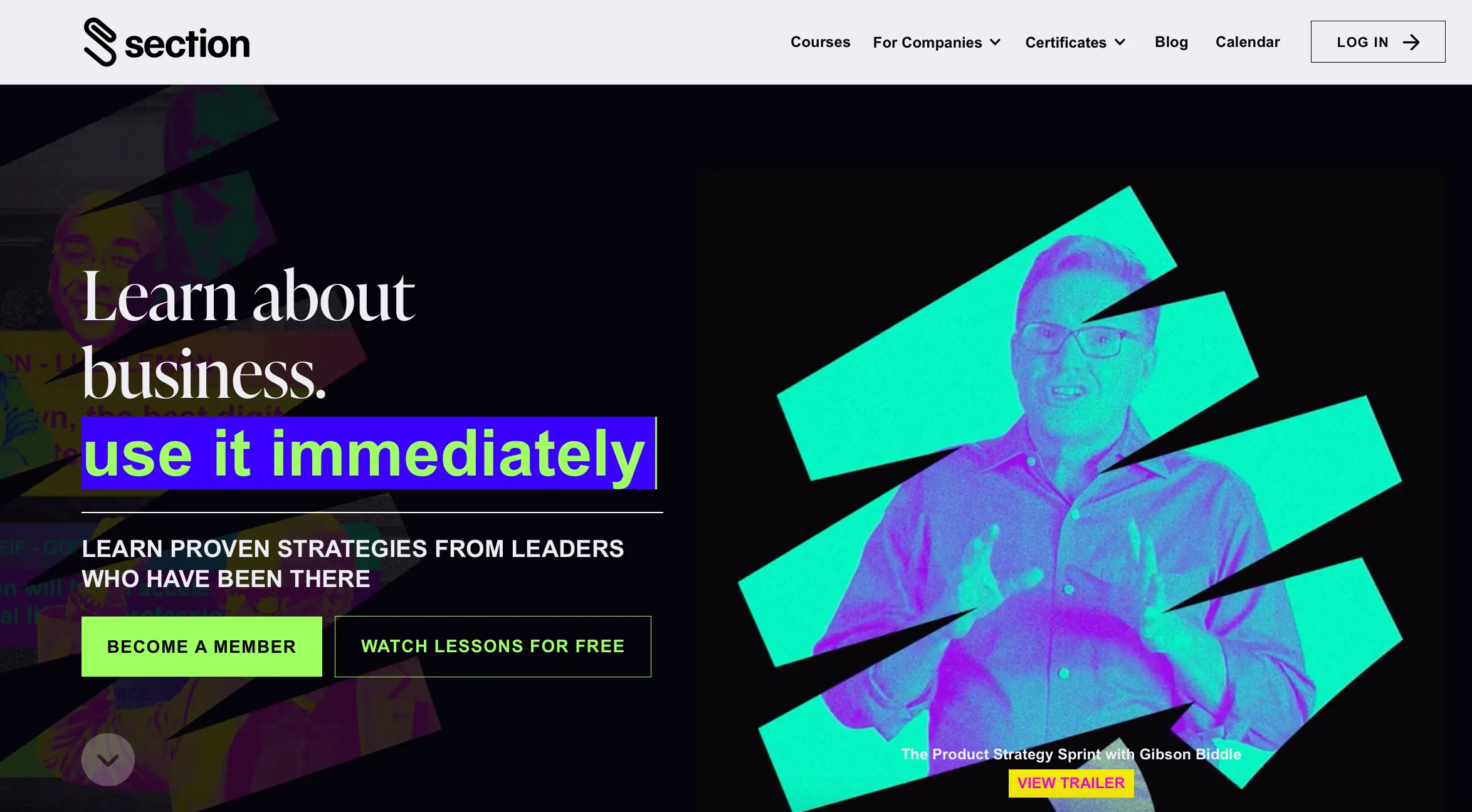Wouldn’t it be helpful if you could understand why and how a company did a rebrand, instead of just seeing the glossy result?
Here’s the no-bullshit, behind-the-scenes look at the Section rebrand (and how you can do the same).

Section4 was founded in 2019 with the goal of providing top-notch business education to all.
It was a great mission, but our brand didn’t live up to it. In short, it wasn’t passing Scott Galloway’s three hurdles:
The three hurdles
Relevance
Does anyone actually care, and is there a big enough market for what you're selling?
Differentiation
Do you stand out from your competitors in a meaningful way?
Sustainability
Can you defend your brand strategy, or is it easy to replicate?
Let's break down how we were doing across the three hurdles.
Scoring our old brand against the three hurdles
Relevance: B+
We launched our first sprint about five days before the COVID-19 lockdown started, pretty much the perfect time to launch an engaging, virtual business platform.
And affordable business education is undoubtedly relevant. The average cost of an MBA was $225,605 in 2022, and applications to MBA programs are dropping as the recession looms.
That said, we had issues with relevance as well. Our brand was most relevant to Scott Galloway superfans, and while that's a large group, it also limits us. We needed a way to inject what makes Scott special into the rest of the brand, without depending entirely on his persona for growth.

Differentiation: D
Differentiation in the edtech market is hard to come by. Most companies in the category stand for the same thing ("helping you upskill") and doing it in the same way (aspirational language, similar-looking design, near-identical offerings).
As a consumer or an enterprise buyer, it's hard to tell them apart and even harder to make an informed decision on where to learn.

But even when you know differentiation is important, it's also tempting to look to your competitors and think, "If they're doing that, we should do it too."
While we were making radically different courses inside our member experience, externally, we were looking too often to our competitors.

Sustainability: C
Internally, we have a sustainable differentiation: we make real, refreshing courses with extremely high completion rates (70%) that are hard for competitors to copy.
But because our external brand didn't mirror our member experience, it was easy to copy. We'd often see competitors borrowing our language (see: sprints) and spinning up brands that looked similar to ours. (Not that we weren't guilty of this too).
On top of that, we had started outgrowing our name.
The "4" in Section4 originally nodded to The Four: Amazon, Apple, Google, and Microsoft, the behemoths that every company was going to have to take on. But as we grew and business changed, "the four" were no longer the only threats to legacy companies.
Plus, people got our name wrong a lot, making it hard for us to scale.

We went back to basics: what do we stand for in the minds of our students?

We eliminated associations that didn't pass the three hurdles
Elite professors were touted by every one of our competitors, including top business schools.
Diverse student bodies were increasingly common among edtech platforms – and even if they didn't really have a diverse student body, they said they did anyway.
Community-driven wasn't differentiated, and we knew from experience that people didn't purchase because of community (even if they stayed with us because of it).

The thing that made us special (our students said) was applicability
Relevance: A
70% of people don’t feel prepared for the future of work, and MBAs are increasingly unaffordable. Current video libraries (you know the ones we mean) are full of boring, mediocre content that you can barely sit through, let alone use. As business continues to change rapidly and the job market compresses, building applicable skills will be even more important.
Differentiation: B
Other edtech companies certainly claim to have highly applicable content. That's often the challenge in establishing a "brand essence" – similar products will usually promise a similar outcome. That's why we had to differentiate in our design and tone (what Scott calls "the texture of your brand") as well.
Sustainability: A-
Completion rates don't lie. Other brands can't say they're applicable, but already, students, companies, and particularly L&D leaders know the difference between an education that's useful and one that isn't even used. We're sure we'll have copycats, but we also believe it's hard to build an edtech platform that people actually engage in.

Our design system is built around the concept of applying what you learn
Post-its, highlighters, and strike-outs evoke the real world of work and the learning process, which is fast, messy, exhilarating, and full of back-and-forth – not a gift handed down from on high by the elites.
Our new logo uses a twisted paper clip to playfully communicate “business ed with a twist” (plus nod to Clippy, the OG business mascot).
Black-and-white photography pokes fun at traditional "stock" business photos, and uses more realistic images to show people working from home, dealing with their kids, being trampled on by a cat, etc.



Oh, and about that name…
The 4 was our origin, but there are no longer just four big threats in business. We considered a number of other names, but ultimately we liked Section – a simplified, memorable version of where we came from.
Section (n): the tight-knit cohort of students you complete a traditional business school program with, modernized for the digital age.
Have feedback on our rebrand?
We'd love to hear it. You can reach out directly with praise, flames, or questions to rachel@sectionschool.com.










